Great read from the APP:
Why New Jersey needs millennials
Conversation and laughter blend with the beat of the music permeating the stylish bar that is intimately lit with votive candles and glass fixtures.
Jennifer Keleman, 28, and her fiancee, nestled together on an oversized sofa, clink their wine glasses. It’s her birthday and they are celebrating at one of their favorite Asbury Park hot spots. Even if the celebration includes multiple glasses of wine, they’re only a short walk from their oceanfront apartment. No driving involved.
“In Asbury Park I feel that I can walk to bars and restaurants. I can go to the beach in the same day. I can go back to my apartment for lunch to walk my dog,” Keleman said. ” I can do that all without having to necessarily get in my car and drive somewhere and that’s really appealing to me.”
The urban landscape offered in towns like Asbury Park and Jersey City make them more attractive to millennials, aka Generation Y. But the rest of New Jersey is unappealing to them.
There’s a lot at stake for the Garden State. The generation has 75 million people, and they aren’t drawn to the landscape of malls and homes that suited WWII and Boomer families migrating from inner cities to safe, quiet suburbs.
Millennials amassed billions in student loan debt due to the sky rocketing cost of college tuition. The scarcity of high paying jobs makes it difficult to pay down the debt faster. Four of 10 millennials in New Jersey are in such dire straits that they live in their childhood home, U.S. Census data shows.
“They’ve delayed being launched,” said Cliff Zukin, a Rutgers University professor who has studied generational changes on American society. “They’re going to delay marriage, having jobs, kids, buying houses.”
The combination of problems is causing New Jersey millennials to migrate out of state, a Rutgers University study found.
With fewer members of Generation Y in New Jersey, there will be fewer people to buy houses, pay taxes, start families and spend money.

